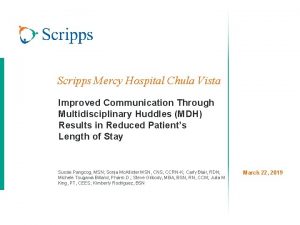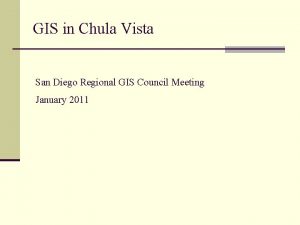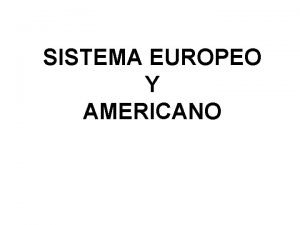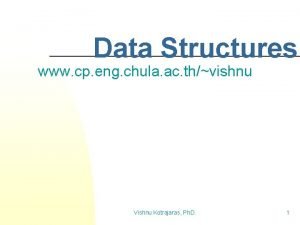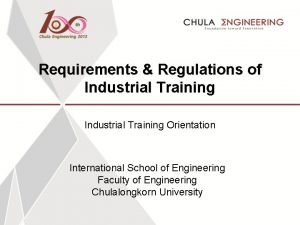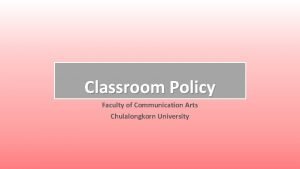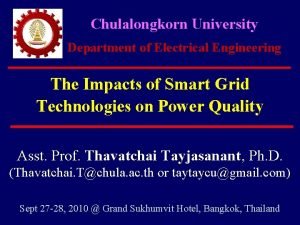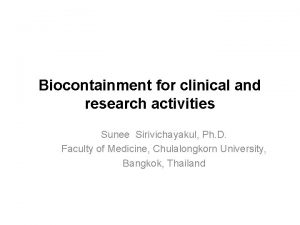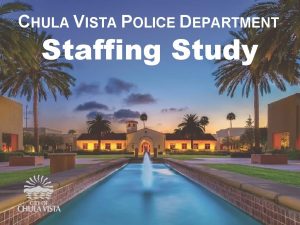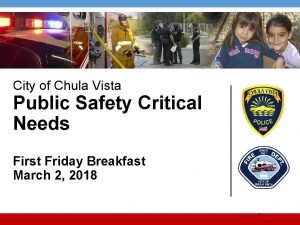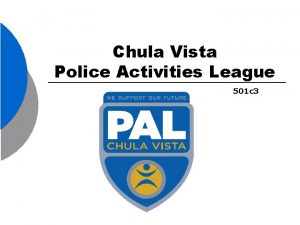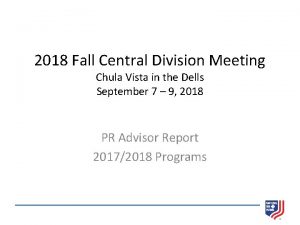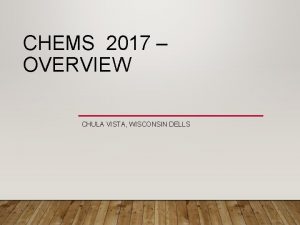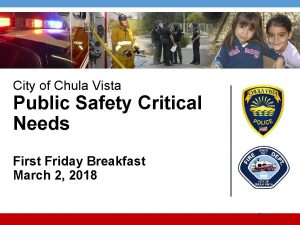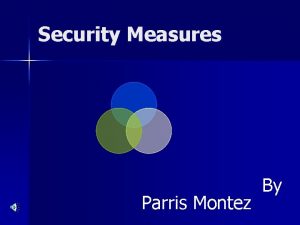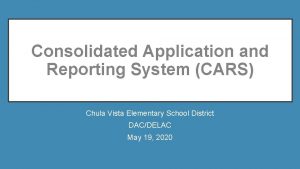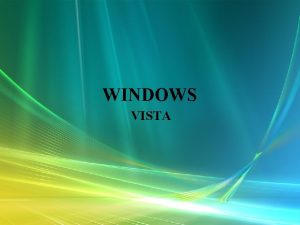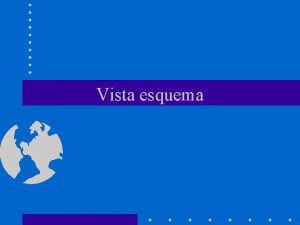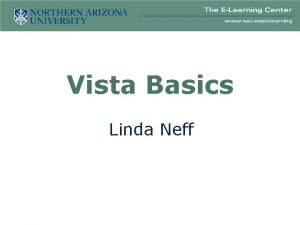EnergyEfficient Community Development The Chula Vista Research Project

















- Slides: 17

Energy-Efficient Community Development

The Chula Vista Research Project > Sponsored by > U. S. DOE - Office of Policy & International Affairs Advancing the objectives of the U. S. Clean Energy & Clean Energy Technology Export Initiatives (CEI & CETEI) > U. S. Global Energy Center at Gas Technology Institute (GTI) On contract to DOE/OPI to develop & disseminate design models, planning tools and professional training for energy-efficient community development

Chula Vista Research Project - Objectives > Integrate advanced energy efficiency, conservation & renewable energy (EECRE) technologies & strategies in community design & development > Formulate design & development patterns to optimize technology performance > Explore new business models & partnerships to advance the objective > Address legislative, regulatory & market barriers to the deployment of these technologies & strategies in community development projects – Explore mechanisms to stimulate market demand for EECRE technologies > Create model designs & development guidelines that encourage & facilitate use of EECRE technologies & strategies > Advance establishment of a national research, education, training & demonstration site for community-scale energy efficiency

Research Site – Otay Ranch, Chula Vista, CA

Research Site – Otay Ranch, Chula Vista, CA > 6, 000 -Acre Parcel (the research site is a representative 1, 500 acre subset) > 70, 970 Anticipated Population (27, 389 subset population) > Mixed-Use, Smart Growth Plan Walkable villages, transit-oriented, green belts > Shared University Campus U. S. & Mexico grad. & undergrad. programs > Science & Technology R&D Park Energy, environmental, healthcare, sports medicine, biotechnology > U. S. Olympic Training Center Collaborative facility use plan > International Plaza Conference facilities Trade & commerce center Technology transfer center Cultural & entertainment amenities

Research Site – 3 Development Projects ~1, 500 acres, accommodating 27, 389 residents in 10, 306 dwelling units Village Two (V-2) Ø Developer: Otay Ranch Company Ø 777 acres – predominantly residential Ø Avg. density = 8 dwelling units/acre – 23% residential, 2% commercial retail, 17% mixed-use, 9% industrial, 11% institutional, 38% recreational Eastern Urban Center (EUC) Village Nine (V-9) Ø Developer: Mc. Millin Land Development Ø Developer: Otay Land Company Ø 290 acres – predominantly commercial Ø 418 acres – residential & institutional Ø Avg. density = 41. 2 dwelling units/acre Ø Avg. density = 15. 6 dwelling units/acre > 16% commercial retail, 16% comm. office, 34% mixed-use (res. /comm. ), 21% institutional, 13% recreational > 15% residential, 1% comm. retail, 43% mixed-use residential, 22% institutional, 19% recreational

Chula Vista Research Project - Diagram BUSINESS -AS-USUAL (BAU) ENERGY TECHNOLOGIES & COMMUNITY DEVELOPMENT PRACTICES ENERGY CONSUMPTION Electric Gas Cooling Hot Water Petroleum & END-USES Structures EQM Systems Municipal Infrastructure Public & Private Mobility ALTERNATIVE (ALT) ENERGY & DEVELOPMENT OPTIONS Renewable & Alternative Fuels Higher Residential Densities Distrib. Generation Efficiency-Optimizing Land Uses District Energy Systems Transit-Oriented Development End-Uses Technologies Heat Island Control Strategies Demand Response Controls Neighborhood Resource Centers COMPUTER MODELING OF BAU & ALT IMPACTS Building Energy Analyzer Energy-10 City-Green Community. Viz Co-Registered Databases STAKEHOLDER INPUT Private Builders & Investors Investor Owned Utilities Municipal Departments Realtors & Homebuyers State Regulatory Agencies Environmental Advocates Labor Advocates BAU & ALT IMPACTS Energy Efficiency Economic Efficiency Environmental Quality Utility Asset Utilization Energy Reliability & Security FEASIBILITY OF ALTS. Economic ROI Marketability Institutional (Leg. & Reg. ) Stakeholder Acceptance DELIVERABLES Feasible Set of Integrated Energy & Development Options Recommended Set of Market & Institutional Innovations Set of Transferable Resources for California Communities

Research Project – Tasks & Schedule > Task I Research Assumptions & Methods > Task II Baseline Energy & Impact Modeling > Task III Integrated Energy Technology & Urban Design Options > Task IV Stakeholder Review & Feasibility Analysis > Task V Recommendations & Transferable Resources > Current Research Schedule > Village 2 = November 2005 through October 2006 > Eastern Urban Center & Village 9 = June 2006 through April 2007

Deliverables & Methodology > Task I Research Assumptions & Methods – Deliverable: Report containing a registry of the assumptions & analytical methods used in the research project & lessons learned for future research > Methodology – Adopt & convert the U. S. DOE/GTI “Future Grid Assumptions Manual” framework to build the Chula Vista project registry – Engage CEC, U. S. DOE, NREL, GTI, SDSU, UCSD & SDG&E (and the parent SEMPRA) in populating the registry for use – Update the registry throughout the entire research project – Translate the registry into a transferable resource for use in community developments elsewhere in California & the U. S. – Seek input & approval from the Project Advisory Committee prior to release

Deliverables & Methodology > Task II Baseline Energy & Impact Modeling – Deliverable: Report quantifying the community’s current & projected energy consumption, costs, energy-related pollutants & utility asset utilization based on business-as-usual energy technologies & planned build-out > Methodology – Estimate energy consumption & economic & environmental impacts for: – Residential, commercial, industrial & institutional buildings – Potable water filtration & distribution – Wastewater treatment & reclamation – Street lighting, traffic controls & signals –Transit & fleet operations – Watershed, open space & habitat management – Solid waste collection, recycling & landfill operations – Other major contract services – Transportation infrastructure – Develop projections for these parameters to the year 2020 based on assumptions contained in the Otay Ranch Development Plan

Deliverables & Methodology > Task III Integrated Energy Technology & Urban Design Options – Deliverable: Report containing cost-benefit analysis of advanced energy technologies for multiple building types, clusters & district energy systems – Deliverable: Report containing cost-benefit analysis of alternative development patterns / designs to optimize energy efficiency & resource conservation – Deliverable: Report containing integrated energy technology & urban design (ET&UD) options > Methodology – Select typical building clusters for the 3 Specific Planning Areas (SPAs) & conduct sensitivity analysis of alternative energy technologies relative to installation & operating costs, efficiencies & emissions – Assessments will cover energy efficiency, renewable energy, demand response, distributed & cogeneration technologies & district energy systems – Explore alternative land use development patterns that optimize technology performance, heat island reduction & passive solar heating, cooling & lighting – Synthesize findings & formulate several ET&UD options for each SPA

Deliverables & Methodology > Task IV Stakeholder Review & Feasibility Analysis – Deliverable: Report containing stakeholder input on ET&UD options – Deliverable: Report containing a series of studies examining institutional & market barriers & solutions relative to the proposed ET&UD options – Deliverable: Report containing planning & development guidelines that encourage & facilitate implementation of the ET&UD options > Methodology – Engage Federal, State & Chula Vista personnel to examine legislative & regulatory barriers & solutions for ET&UD option implementation – Engage the development & finance communities to explore alternative means of financing integrated ET&UD development projects – Generate a set of recommended ET&UD policies & performance targets for the 15 -year planning horizon & solicit community stakeholder input – Formulate a set of recommended revisions to the Otay Ranch Development Plan to facilitate ET&UD implementation

Deliverables & Methodology > Task V Recommendations & Transferable Resources – Deliverable: Report with recommendations for legislative, regulatory & market initiatives to overcome barriers to energy-smart community development – Deliverable: Report summarizing the transferable elements of the Chula Vista research project & guidelines, methods & tools for energy-smart community development > Methodology – Issue recommendations for needed legislative & regulatory innovations to advance energy-smart development – Differentiate research methods & tools deemed appropriate for greenfield, brownfield & infill development projects – Translate research findings into practical tools for use by other communities pursuing energy-smart development

Chula Vista Research Project Participants & Tasks

Chula Vista Research Project Task Schedule Tasks / Months Nov Dec Jan Feb Mar Apr 2005 May Jun Jul Aug Sep Oct Nov Dec Jan 2006 1. Define Research Assumptions & Methods = Easter Urban Center & Village Nine 2. Model Baseline Energy & Impacts Easter Urban Center & Village Nine 3. Model ET & UD Design Options Easter Urban Center & Village Nine 4. Stakeholder Review & Feasibility Analysis Easter Urban Center & Village Nine 5. Develop Recommendations & Transferable Resources Easter Urban Center & Village Nine www. globalenergycenter. org Mar 2007 = Village Two Core Group Formation Global Energy Center at the Gas Technology Institute Feb 02 -28 -06 Apr

National Demonstration Site Global Energy Network & U. S. Global Energy Center Yellow = Emerging Centers – Global network of collaborating organizations advancing sustainable community energy development – Emerging centers in Argentina, China, Germany, Israel, Japan & the U. S. Red = Potential Centers – City of Chula Vista has offered land to construct the U. S. Center within the Otay Ranch development – Will consist of an international conference center, education & training facility & technology demonstration park – Ongoing discussions in Australia, Canada, India, the Netherlands, Thailand & the United Kingdom

Energy-Efficient Community Development The Chula Vista Research Project For More Information Contact: § Doug Newman, Executive Director U. S. Global Energy Center / Gas Techology Institute doug. newman@globalenergycenter. org 847 -768 -0680 phone www. globalenergycenter. org
 Scripps mercy hospital in chula vista
Scripps mercy hospital in chula vista Chula vista gis
Chula vista gis Metodo europeo dibujo tecnico
Metodo europeo dibujo tecnico Cp chula
Cp chula Reg chula eng
Reg chula eng Faculty of communication arts chulalongkorn university
Faculty of communication arts chulalongkorn university Deguration
Deguration Kobkoonka
Kobkoonka Definition of community development
Definition of community development Hát kết hợp bộ gõ cơ thể
Hát kết hợp bộ gõ cơ thể Slidetodoc
Slidetodoc Bổ thể
Bổ thể Tỉ lệ cơ thể trẻ em
Tỉ lệ cơ thể trẻ em Chó sói
Chó sói Tư thế worm breton
Tư thế worm breton Chúa yêu trần thế
Chúa yêu trần thế Môn thể thao bắt đầu bằng từ đua
Môn thể thao bắt đầu bằng từ đua Thế nào là hệ số cao nhất
Thế nào là hệ số cao nhất
